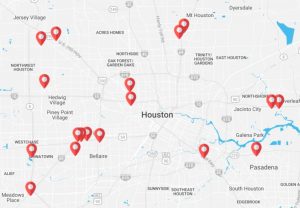Hurricane Harvey, Irma, and Marie were devastating weather disasters. As the storms ripped through the regions, attention focused on the emergency responders and the rescues they performed. Now underway is the work of the “second responders.”
A report released this week provides information on part of the second responder workforce in Houston: day laborers. “After the Storm: Houston’s day labor markets in the aftermath of Hurricane Harvey” is based on surveys completed by 361 day laborers. They were recruited at 20 informal hiring sites around Houston, such as the parking lots of convenience or home improvement shops. The survey included questions about the type of work they had been performing since Harvey struck and hazards they encountered.

During a press call on Tuesday, November 21, Nik Theodore, author of the report and professor of urban planning and policy at the University of Illinois at Chicago, presented some of the survey findings. The day laborers reported that during week three after the hurricane, they did the following work:
- 57% of jobs were for construction and landscaping contractors
- 35% were for private households, and
- 8% were for non-construction-related businesses
Within the construction and clean-up jobs, the most common tasks performed were:
- Removing and repairing sheetrock
- Removing debris and unwanted items
- Roofing
- General remodeling
The day laborers were asked about health problems they associated with working in hurricane-affected areas.
- 40% reported watery eyes or eye infections
- 35% report recurring headaches
- 28% reported skin rashes and swelling
- 27% reported difficulty breathing
The survey respondents were largely long-time residents of Houston. Sixty-six percent had lived in the Houston area for at least five years. Fewer than 10% reporting living in region for less than one year.
“After the Storm” complements a more extensive research project led by Dr. Maria Fernandez-Esquer at the University of Texas Health Science Center’s School of Public Health in Houston. “Proyecto Vales+Tú” is a community-based participatory research action project that has been examining the work-related injury experiences of Latino day laborers in Houston. The research team identified more than 44 “corners” located inside the City of Houston’s Highway 8 beltway. One of the project’s aims was to design and pilot test a culturally responsive injury prevention program. The title“Proyecto Vales+Tú” means “you are worth more,” which was coined by day laborers who were involved in the project.
Dr. Fernandez-Esquer and her team have presented the successful results of the pilot program at the American Public Health Association’s annual meeting. When I tried to reach her yesterday, she was at one of the corners speaking with day laborers. She is currently engaged in another pilot study to compare day laborers’ experiences during hurricane Harvey with those she documented in previous hurricane recovery situations (e.g., Hurricane Ike).
The report “After the Storm” was commissioned by the Fe y Justicia Worker Center and the National Day Laborer Organizing Network. Both organizations aim to improve labor practices for individuals working in the informal employment arrangements. These workers make up a sizable share of the labor market in Houston. They are now relied upon to perform disaster clean-up and recovery work, but they are particularly vulnerable to unsafe working conditions and not being paid what they are owed.
Government officials and community leaders are quick to praise emergency responders who risk their lives to rescue those caught in storms. Second responders” haul the disaster away and bring normalcy to neighborhoods. Some might want recognition, but I suspect many more simply want to be given the tools they need to do their jobs safely, get medical care if they are injured, and are paid a fair wage.

Letter to the Editor
The Pump Handle
11/26/17
Dear Editor:
On 11/22/17, you reported that after the Hurricane Harvey, laborers contributed significantly to the rehabilitation of hurricane-affected areas that needed some love and care.
This is interesting because the laborers came together to help heal the city from the aftermath of the natural disaster, but there was no sort of policy implemented to help them receive the care they needed after experiencing negative health outcomes as a result of attempting to kick the disaster out and bring a sense of regularity back to the community after such a tragedy.
As a current student in public health, my perspective is that there should be some sort of policies implemented that allow the second responders to receive the medical care that they definitely earned and deserve.
One thing that could really make a difference is possibly a relief fund with a pool of money stashed away for the second responders, or a way to allow them to be the first one’s seen by medical providers once they complete the tasks they set out to do. You said that these workers make up a substantial portion of the labor force, so it’s only right that they are taken care off for all that they do. Thank you.
Sincerely,
Tremone Fucles
[Tremone Fucles, tremone@berkeley.edu, (757) 327-3500)]
Tremone,
Thank you for your thoughtful comment. I agree that there should be public health policies in place for “second responders.” We need to make sure that some of the BILLIONS of federal dollars being awarded to states and localities following these weather events are set aside for occupational health and safety. This would include prevention-related topics, such as providing safety and know-your-rights training, and ensuring the second responders have appropriate safety equipment. I agree that we need also to make sure that they receive appropriate and prompt medical care in the event they are injured performing the vitally important clean-up and recovery work.
Because you are a public health student, I hope you will become a regular reader of our blog. I know you already recognize the significance of its title 🙂